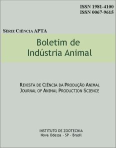Nutritive traits of sugar-cane ensiled with calcium hydroxide
Keywords:
feeding, intake, digestibility, fermentation, sheepAbstract
Now-a-days, conservation of sugar cane as silage has been highlighted due some operational benefits. Nevertheless when ensiled without additives shows alcoholic fermentation with loss of nutritive value, due to yeast fermentation. Considering the hypothesis that the use of lime at ensiling sugar-cane may inhibit the development of yeast and decreases ethanol production and loss of silage nutritive value, the trial was developed aimed at evaluating some nutritive traits of sugar-cane ensiled with calcium hydroxide (hydrated lime). The treatments were T1-sugar cane ensiled with 0.25% of lime; T2 - sugar cane ensiled with 0.50% of lime; T3 - sugar cane ensiled with 0.75% of lime and T4 - sugar cane ensiled with 1 % of lime. All treatments were added 1% of urea at feeding time. Twenty sheep located on individual crates were used to evaluate the intake and digestibility through total feces collection on a randomized blocks design. The voluntary intake and the apparent digestibility coefficients of dry matter, crude protein, and fiber in neutral detergent, fiber in acid detergent were evaluated. The addition of 1% of lime to the ensiling sugarcane caused a reduction of cellular wall, increase on dry matter intake and digestibility coefficients, which led to more desirable traits to the silage.
Downloads
Downloads
Published
Issue
Section
License
Os autores não serão remunerados pela publicação de trabalhos, pois devem abrir mão de seus direitos autorais em favor deste periódico. Por outro lado, os autores ficam autorizados a publicar seus artigos, simultaneamente, em repositórios da instituição de sua origem, desde que citada a fonte da publicação original seja Boletim de Indústria Animal. A revista se reserva o direito de efetuar, nos originais, alterações de ordem normativa, ortográfica e gramatical, com vistas a manter o padrão culto da língua e a credibilidade do veículo. Respeitará, no entanto, o estilo de escrever dos autores. Alterações, correções ou sugestões de ordem conceitual serão encaminhadas aos autores, quando necessário. Nesses casos, os artigos, depois de adequados, deverão ser submetidos a nova apreciação. As opiniões emitidas pelos autores dos artigos são de sua exclusiva responsabilidade. Todo o conteúdo deste periódico, exceto onde está identificado, está licenciado sob a Licença Creative Commons Attribution (CC-BY-NC). A condição BY implica que os licenciados podem copiar, distribuir, exibir e executar a obra e fazer trabalhos derivados com base em que só se dão o autor ou licenciante os créditos na forma especificada por estes. A cláusula NC significa que os licenciados podem copiar, distribuir, exibir e executar a obra e fazer trabalhos derivados com base apenas para fins não comerciais.













